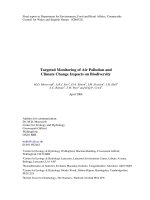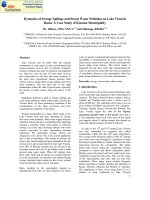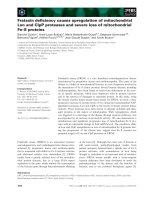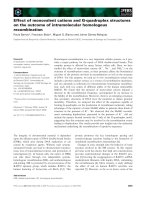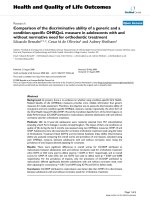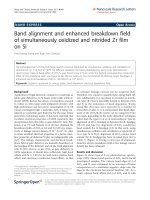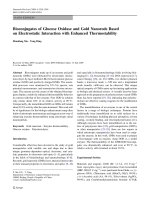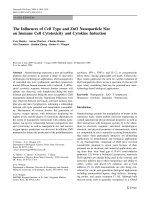Up-regulation of HER2 by gemcitabine enhances the antitumor effect of combined gemcitabine and trastuzumab emtansine treatment on pancreatic ductal adenocarcinoma cells
Bạn đang xem bản rút gọn của tài liệu. Xem và tải ngay bản đầy đủ của tài liệu tại đây (928.72 KB, 9 trang )
Kan et al. BMC Cancer (2015) 15:726
DOI 10.1186/s12885-015-1772-1
RESEARCH ARTICLE
Open Access
Up-regulation of HER2 by gemcitabine
enhances the antitumor effect of combined
gemcitabine and trastuzumab emtansine
treatment on pancreatic ductal
adenocarcinoma cells
Shin Kan1, Shigeo Koido1,2, Masato Okamoto4, Kazumi Hayashi1,3, Masaki Ito1, Yuko Kamata1, Hideo Komita5,
Eijiro Nagasaki3 and Sadamu Homma1*
Abstract
Background: Although pancreatic ductal adenocarcinomas (PDAs) widely express HER2, the expression level is
generally low. If HER2 expression in PDA cells could be enhanced by treatment with a given agent, then
combination therapy with that agent and trastuzumab emtansine (T-DM1), a chemotherapeutic agent that is a
conjugate of trastuzumab, might lead to significant antitumor effects against PDA.
Methods: Cell proliferation was examined by spectrophotometry. HER2 expression was examined by flow
cytometry, immunoblot and quantitative reverse transcription polymerase chain reaction. T-DM1 binding to cells
was examined by flow cytometry and enzyme-linked immunosorbent assay.
Results: Out of 5 tested human PDA cell lines, including MIA PaCa-2, three showed increases in HER2 expression
after gemcitabine (GEM) treatment. The binding of T-DM1 to GEM-treated MIA PaCa-2 cells was higher than to
untreated MIA PaCa-2 cells. Treatment with GEM and T-DM1 showed synergic cytotoxic effects on MIA PaCa-2 cells
in vitro. Cells in the G2M phase of the cell cycle were retained after GEM treatment and showed higher levels of
HER2 expression, possibly contributing to the synergic effect of GEM and T-DM1.
Conclusions: Combined treatment with GEM and T-DM1 might confer a potent therapeutic modality against PDA
as a result of GEM-mediated HER2 up-regulation.
Keywords: Pancreatic ductal adenocarcinoma, Human epidermal growth factor receptor 2, Gemcitabine,
Trastuzumab emtansine, Combination therapy
Background
Pancreatic ductal adenocarcinoma (PDA) is presently the
fifth leading cause of cancer-related deaths in Japan [1].
As PDA shows highly infiltrative and metastatic behavior
and because most PDA patients are at an advanced stage
upon diagnosis, the number of PDA patients who qualify
for curable surgical treatment is low. Furthermore, even if
PDA is resected, it exhibits frequent recurrence after
* Correspondence:
1
Division of Oncology, Research Center for Medical Sciences, Jikei University
School of Medicine, Tokyo, Japan
Full list of author information is available at the end of the article
surgical treatment, and its 5-year survival rate is only
18.8 % [2]. Accordingly, the establishment of an effective
therapeutic modality is an urgent issue.
Human epidermal growth factor receptor 2 (HER2) is
a 185-kDa transmembrane glycoprotein with tyrosine
kinase receptor activity, which provides signal transduction for cell proliferation and differentiation [3]. It has
been reported that overexpression of HER2 is found in
15-25 % of breast cancers and is related to poor prognosis
[4, 5]. Trastuzumab, a monoclonal antibody that recognizes the HER2 protein, specifically binds to the extracellular HER2 receptor and elicits anti-tumor activity by
© 2015 Kan et al. Open Access This article is distributed under the terms of the Creative Commons Attribution 4.0
International License ( which permits unrestricted use, distribution, and
reproduction in any medium, provided you give appropriate credit to the original author(s) and the source, provide a link to
the Creative Commons license, and indicate if changes were made. The Creative Commons Public Domain Dedication waiver
( applies to the data made available in this article, unless otherwise stated.
Kan et al. BMC Cancer (2015) 15:726
blocking signal transduction and antibody-dependent cellmediated cytotoxicity (ADCC) [6]. The treatment of
HER2-overexpressing breast or gastric cancer patients
with trastuzumab in combination with chemotherapeutic
agents is being evaluated in phase III clinical studies and
is more effective than standard chemotherapy [7, 8]. It is
known that PDAs widely express HER2 (10-82 %) [9–13].
Although trastuzumab treatment against human PDA
cells has shown significant antitumor activity in basic in
vivo and in vitro studies, the combined treatment of gemcitabine (GEM) or capecitabine with trastuzumab against
metastatic PDA did not result in improved progressionfree survival or overall survival, possibly because the expression and gene amplification of HER2 in PDAs were
generally lower than in breast cancer [14, 15].
Trastuzumab emtansine (T-DM1) is a recently developed conjugate of trastuzumab and DM1 (derivative of
maytansine 1), a chemotherapeutic agent. When T-DM1
binds to cell-surface HER2 receptors, it is delivered into
the lysosome via endocytosis and digested. The active
form of DM1 is released into the cell and inhibits the
assembly of microtubules [16, 17]. Therefore, T-DM1
exerts selective anti-tumor effects more strongly than
trastuzumab. In preclinical studies, the cytotoxic activity
of T-DM1 in breast and gastric cancer cells was stronger
than that of trastuzumab, even if the tumor cells were
resistant to trastuzumab [18, 19]. In clinical studies, the
antitumor effect of T-DM1 was found to be superior to
those of lapatinib and docetaxel in patients with HER2positive advanced breast cancer that was resistant to
trastuzumab and taxanes [20].
One possible reason why trastuzumab has not been
applied as a treatment for PDA might be because PDA
cells exhibit low levels of HER2 expression. Therefore, if
HER2 expression in PDA cells could be enhanced by
treatment with some agent, combination therapy with
that agent and T-DM1 might show a significant antitumor effect because more T-DM1 could be delivered into
PDA cells. We have found that GEM can enhance HER2
expression in PDA cells; as such, a combined treatment of
GEM and T-DM1 may provide a potent therapeutic effect
against PDA. In the present study, HER2 up-regulation by
GEM treatment and the synergistic cytotoxic effect of
GEM and T-DM1 against PDA cells were examined.
Page 2 of 9
deactivated fetal bovine serum. Gemcitabine (GEM)
was purchased from Eli Lilly Japan (Kobe, Japan),
five-fluorouracil (5FU) was purchased from Kyowa
Hakko Kirin Co. (Tokyo, Japan), and oxaliplatin (L-OHP)
was purchased from Sigma-Aldrich (St. Louis, MO, USA).
Trastuzumab was a gift from Chugai, Inc. (Tokyo, Japan),
and trastuzumab emtansine (T-DM1) was provided by
Genentech Inc. (South San Francisco, CA, USA).
Flow cytometric analysis
To assess HER2 expression levels, cells were incubated
either with phycoerythrin (PE)-labeled anti-human
HER2 (24D2) or with corresponding isotype-control
antibodies (BioLegend, San Diego, CA, USA) in buffer
(1 % FBS, 2 mM EDTA and 0.1 % NaN3 in PBS) for
30 min at 4 °C, after which they were washed and then
analyzed using a MACSQuant Analyzer (Miltenyi Biotech
K.K., Bergisch Gladbach, Germany). Before using the
analyzer, 4 μg/ml propidium iodide (PI) (Sigma-Aldrich,
St. Louis, MO, USA) was added to each sample to exclude
dead cells.
To assess T-DM1 binding to PDA cells, 0.5x106 cells
were incubated with 30 μg/ml T-DM1 at 37 °C for 1 h.
The cells were washed, incubated with PE-labeled antihuman IgG Fc (HP6017) (Biolegend) or corresponding
isotype-control antibodies (Affymetrix, Santa Clara, CA,
USA) in buffer for 30 min at 4 °C, washed, re-suspended
and analyzed using a MACSQuant Analyzer (Miltenyi
Biotech K.K.). Before using the analyzer, 4 μg/ml PI
(Sigma-Aldrich) was added to the sample to exclude
dead cells. The mean fluorescence intensity (MFI) of
HER2 was analyzed using MACSQuantify Software.
Cell cycle analysis
MIA PaCa-2 cells were suspended in Hoechst 33342
(5 μg/ml) (Life Technologies) and incubated at 37 °C for
90 min, then washed and incubated with phycoerythrin
(PE)-labeled anti-human HER2 (24D2) or the corresponding isotype control antibodies (BioLegend) for
30 min at 4 °C. Before using the analyzer, 1 μg/ml PI
(Sigma-Aldrich) was added to the sample to exclude
dead cells. In cell cycle analysis, the mean fluorescence
intensity (MFI) of HER2 in each phase of the cell cycle
was examined using MACSQuant Analyzer (Miltenyi
Biotech K.K.) and MACSQuantify Software.
Methods
Cell lines and agents
The human pancreatic adenocarcinoma (PDA) cell lines
MIA PaCa-2, PANC-1, AsPC-1, Capan-1 and Capan-2
were obtained from the American Type Culture Collection
(Manassas, VA, USA) [21]. All cell lines were cultured in
Dulbecco’s modified Eagle medium (Nissui Pharmaceutical,
Tokyo, Japan) supplemented with penicillin/streptomycin
(Life Technologies, Carlsbad, CA, USA) and 10 % heat-
Quantitative reverse transcription polymerase chain
reaction (qRT-PCR)
The cells were lysed in RLT Plus Buffer (Qiagen, Hilden,
Germany) and homogenized. From 2 μg of total RNA,
cDNA was synthesized using a High-Capacity cDNA Reverse Transcription kit (Applied Biosystems, Foster City,
CA, USA) and a GeneAmp PCR System 9700 (Applied
Biosystems). For qRT-PCR detection of HER2 and 18S
Kan et al. BMC Cancer (2015) 15:726
rRNA, 5 ng of cDNA was amplified using SYBR Premix
Ex Taq II (Takara Bio Inc., Otsu, Shiga, Japan) and a
7300 Real-Time PCR System (Applied Biosystems). The
PCR conditions consisted of an initial denaturation step
(95 °C for 30 s), followed by 40 cycles (95 °C for 5 s and
62 °C for 31 s) and a dissociation step (95 °C for 15 s,
60 °C for 60 s and 95 °C for 15 s, and 60 °C for 15 s).
The sequences of the primers (Operon Biotechnologies
K.K., Tokyo, Japan) for HER2 and the 18S ribosomal
RNA (rRNA) that were used in the present study were
as follows: 5’-TCCTGTGTGGACCTGGAT-3’ as a forward primer and 5’-TGCCGTCGCTTGATGAG-3’ as a
reverse primer for human HER2; 5’-CGGCTACCA
CATCCAAGGAA-3’ as a forward primer and 5’GCTGGAATTACCGCGGCT-3’ as a reverse primer for
human 18S rRNA. The data were analyzed using the
comparative ΔΔCT method by calculating the difference
between the threshold cycle (CT) values of the target
and reference genes of each sample and then comparing
the ΔCT values of each drug treatment to the nontreated group.
Immunoblot analysis
Cells were homogenized in 20 mM HEPES buffer containing 1 % Triton X-100, 100 mM PMSF, 1 mg/ml leupeptin, 1 mg/ml aprotinin and 0.9 M Na3VO4, and the
protein concentrations of the homogenates were analyzed using a Pierce BCA Protein Assay Kit (Thermo
Fisher Scientific Inc., Waltham, MA, USA). Protein samples (10 μg) were separated by electrophoresis on a
7.5 % sodium dodecyl sulfate-polyacrylamide gel (ATTO,
Tokyo, Japan) and transferred to a polyvinylidene
difluoride membrane (Bio-Rad Laboratories, Hercules,
CA, USA). After blocking with 3 nonfat milk and 3 %
bovine serum albumin for 1 h, the membrane was
treated with Abs against HER2 (1:1000) (e2-4001 + 3B5,
Thermo Fisher Scientific Inc., Waltham, MA, USA) and
glyceraldehyde 3-phosphate dehydrogenase (GAPDH)
(1:600,000) (2D4A7, Abcam Inc, Cambridge, UK) and
then with horseradish peroxidase-conjugated secondary
antibodies (Cell Signaling Technology Inc., Danvers, MA,
USA). Chemi-Lumi One Super (Nakalai Tesque Inc,
Kyoto, Japan) was used for chemiluminescent detection.
When HER2 was detected by immunoblot analysis, it
produced two bands of approximately 185 and 155 kDa.
The 155 kDa band has been reported to represent cytoplasmic HER2, whereas the 185 kDa represents
membrane-bound HER2 [22–24].
Enzyme-linked immunosorbent assay (ELISA)
GEM- and T-DM1-treated MIA PaCa-2 cells (1x106
cells) were homogenized in 20 mM HEPES buffer
containing 1 % Triton X-100, 100 mM PMSF, 1 mg/ml
leupeptin, 1 mg/ml aprotinin and 0.9 M Na3VO4. To
Page 3 of 9
quantify human IgG (T-DM1) binding to 1x106 MIA
PaCa-2 cells, a human IgG total Ready-Set-Go kit
(Affymetrix, Santa Clara, CA, USA) was used according
to the manufacturer’s procedures.
Estimation of the anti-proliferative effects of the agents
by an in vitro cell growth assay
MIA PaCa-2 cells and Capan-1 cells were treated with
GEM (0, 30, 100 or 300 ng/ml) for 2 h. After washing
the cells with PBS, they were incubated in medium containing T-DM1 (0, 10 or 30 μg/ml) for 96 h. Then, the
cells were detached by trypsin-EDTA treatment, and the
number of cells that were not stained with trypan blue
was determined using a hemocytometer. Identical numbers of viable cells were seeded into 96-well plates (103/
100 μl/well). After a 96-h incubation, cell growth was
examined by spectrophotometry using the counting reagent SF (Nakarai Tesque Inc, Catalog No. 07553). The
cell count reagent SF is a sensitive colorimetric reagent
that utilizes tetrazolium salt, which is highly watersoluble. Because the absorbance at 450 nm is proportional to the number of viable cells in the medium, the
viable cell number can be determined using the absorbance
value of a previously prepared calibration curve. Fluorescence was measured at 450 nm using an iMark microplate
absorbance reader (Bio-Rad Laboratories, Hercules, CA,
USA). The treatment design is shown in Fig. 1.
Statistical analysis
All data are presented as the mean ± standard deviation
(SD). Comparisons between the untreated control and
drug-treated groups were performed by non-paired
Student’s t-tests for two independent groups and with
Dunnett’s method for multiple-group comparisons. A
p-value of <0.05 was considered statistically significant.
Statistical analyses were performed using Microsoft Office
Excel 2007 (Microsoft Corporation, Redmond, WA, USA)
with the add-on software Statcel3 (OMS publishing Inc.,
Saitama, Japan).
Results
GEM treatment increased HER2 expression in PDA cells
with originally low or moderate HER2 expression
PANC-1, AsPC-1 and MIA PaCa-2 cells showed significant increases in HER2 expression after GEM treatment,
but HER2 expression in Capan-2 cells was not affected
(Fig. 2a). On the contrary, GEM treatment suppressed
HER2 expression in Capan-1 cells. PANC-1, AsPC-1 and
MIA PaCa-2 cells, which showed up-regulated HER2 expression after GEM treatment, originally showed low or
moderate HER2 expression levels. Conversely, Capan-2
and Capan-1 cells, which did not show HER2 upregulation after GEM treatment, exhibited considerably
Kan et al. BMC Cancer (2015) 15:726
Seeding of
PDA cells
Page 4 of 9
GEM
treat.
T-DM1 treat.
2hrs
4 days
24 hrs
Sub-culture
analysis
4 days
Fig. 1 A schematic illustrating how the treatments were performed on MIA PaCa-2 and Capan-1 cells
high levels of HER2 expression prior to treatment
(Fig. 2a).
The augmentation of HER2 expression in MIA PaCa-2
cells following GEM treatment was also examined by
immunoblot analysis. As shown in Fig. 2b, HER2 expression levels, of both membranous and cytoplasmic forms,
in whole cells was enhanced by GEM treatment. However, the expression of HER2 mRNA was not enhanced
2, 6, 12, 24 or 48 h after GEM treatment (Fig. 2c, Additional file 1: Figure S1).
A
AsPC-1
10
8
6
4
2
0
PANC-1
*
0
20
* 8
*
6
4
2
0
100 300 1000
Standard chemotherapeutic agents for PDA treatment
were examined for their abilities to augment HER2 expression in MIA PaCa-2 cells. The incubation time of
each agent was determined based on the time it took to
disappear from the blood when used in cancer chemotherapy. Treatment with 40 μg/ml of five-fluorouracil (5FU) enhanced cell surface HER2 expression by approximately 1.5-fold, and 10 μg/ml of oxaliplatin (L-OHP)
*
Capan-1
20
40
15
30
10
10
20
5
5
10
*
* 15
*
*
0
0
Capan-2
MIA PaCa-2
10
*
The effects on HER2 expression levels of various standard
chemotherapeutic agents for PDA treatment
100 300 1000
0
0
*
*
*
0
100 300 1000
0
100 300 1000
0
100 300 1000
GEM (ng/ml)
C
HER2
(kDa)
250
2
HER2 mRNA
B
150
GAPDH
GEM (ng/ml)
Time (hr)
0
30 100 300
48
1.5
1
0.5
0
GEM (ng/ml)
Time (hr)
0
100
300 1000
6
Fig. 2 HER2 expression was up-regulated by GEM treatment in some PDA cell lines. a Five PDA cell lines were either untreated or treated with
GEM for 2 h, washed with PBS and incubated for another 48 h in fresh medium. HER2 expression was analyzed by flow cytometry. HER2 expression
(ΔMFI) was calculated as the MFI of HER2 minus that of an isotype control. *P < 0.01 (n = 3) vs. untreated samples. b GEM-treated MIA
PaCa-2 cells (0, 30, 100 and 300 ng/ml, 2 h) were incubated for 48 h, and the expression of the HER2 protein in the whole-cell lysates
was analyzed using immunoblots. GAPDH was used as an internal control. c GEM-treated MIA PaCa-2 cells (0, 100, 300 and 1000 ng/ml, 2 h) were
incubated for 2, 6, 12, 24 and 48 h, and the HER2 mRNA level in each treated cell line was determined using qRT-PCR. The HER2 mRNA expression
levels were normalized to that of 18S ribosomal RNA and quantified using the ΔΔCt method. The level of HER2 mRNA at 6 h after GEM treatment is
shown as a representative
Kan et al. BMC Cancer (2015) 15:726
increased HER2 expression by approximately 2.5-fold
(Fig. 3). Treatment with a 100–1000 ng/ml concentration of GEM enhanced cell surface HER2 expression by
approximately 2.5-fold (Fig. 3).
Treating MIA PaCa-2 cells with GEM enhanced T-DM1
binding
Because treating MIA PaCa-2 cells with GEM enhanced
the cell surface expression of HER2, we next examined
whether T-DM1 exhibited enhanced binding to HER2 in
GEM-treated MIA PaCa-2 cells. There was approximately 2-fold higher binding of T-DM1 to GEM-treated
MIA PaCa-2 cells than to untreated MIA PaCa-2 cells
(Fig. 4a, b). The extent of increase in T-DM1 binding to
the GEM-treated MIA PaCa-2 cells paralleled the enhancement in HER2 expression following GEM treatment (Fig. 4a). The amount of T-DM1 that bound to 106
MIA PaCa-2 cells, which were treated or not treated
with GEM, was quantified by ELISA. There was approximately 2.5-fold greater binding of T-DM1 to GEMtreated cells than to untreated cells (Fig. 4c).
Combined treatment with GEM and T-DM1 synergistically
inhibited cell proliferation in MIA PaCa-2 cells
Treatment with both GEM and T-DM1 showed a synergistic anti-proliferative effect when MIA PaCa-2 cells
that were pre-treated with 30 or 100 ng/ml of GEM
were further treated with various doses of T-DM1
(Fig. 5a). The cytotoxic activity of T-DM1 (30 μg/ml) on
GEM -pretreated MIA PaCa-2 cells (100 ng/ml) was
competitively inhibited when trastuzumab was added to
the culture (Fig. 5b). On the contrary, a synergistic antiproliferative effect was not observed when Capan-1 cells,
which did not upregulate HER2 expression in response
to GEM treatment, were treated with GEM and T-DM1
in a similar manner as MIA PaCa-2 cells (Fig. 5c).
Page 5 of 9
G2M cell population of GEM-treated MIA PaCa-2 cells
showed higher HER2 expression than G1 or S cell
population
GEM treatment of MIA PaCa-2 cells induced a marked
decrease in the G1 cell population, but the G2M cell
population was retained (Fig. 6a). Untreated and GEMtreated cells in each phase of the cell cycle were examined for HER2 expression. In each of the phases, HER2
expression in GEM-treated cells was higher than in untreated cells, and the G2M cell population of the GEMtreated cells exhibited higher HER2 expression than the
G1 or S cell populations (Fig. 6b), while HER2 expression in untreated MIA PaCa-2 cells was virtually the
same during each phase of the cell cycle.
Discussion
In the present study, we demonstrated that the expression of HER2 in several human PDA cell lines, including
in MIA PaCa-2, was enhanced by short-term treatment
with GEM. GEM is a nucleoside analog that is widely
used as a standard therapeutic agent against PDA [25].
Although the amount of HER2 protein increased following GEM treatment, HER2 mRNA was unaffected. It is
possible that the enhanced HER2 expression following
GEM treatment was promoted at the translational level
but not at the transcriptional level. Micro RNAs are
small, non-coding RNAs that regulate protein translation
from mRNA. It has been reported that a micro RNA
regulates HER2 expression [26, 27]. In breast cancer,
miR-205 down regulates HER2 [27]. If GEM suppresses
miR-205 function in MIA PaCa-2 cells, HER2 protein
translation might be enhanced, leading to the upregulation of the HER2 protein. It might also be conceivable that the degradation of the HER2 protein is inhibited
by GEM treatment. It has been reported that the degradation of the HER2 protein is processed through polyubiquitination, internalization into cells and lysosomal
Fig. 3 Augmentation of HER2 expression in MIA PaCa-2 cells using standard drugs for PDA treatment. MIA PaCa-2 cells were treated with 5-FU
(0, 2.5, 10 or 40 μg/ml) for 1.5 h, GEM (0, 100, 300 or 1000 ng/ml) for 2 h or L-OHP (0, 2.5, 10 or 40 μg/ml) for 3 h, and HER2 expression was examined
48 h after each treatment by flow cytometry. ΔMFI of HER2 was calculated as the MFI of HER2 minus that of the isotype control. *P < 0.01 vs. untreated
samples (n = 3)
Kan et al. BMC Cancer (2015) 15:726
A
Page 6 of 9
B
C
Fig. 4 GEM treatment increased HER2 expression and resulted in increased T-DM1 binding to MIA PaCa-2 cells. a MIA PaCa-2 cells were either
untreated or treated with GEM (100 ng/ml) for 2 h, washed with PBS and incubated in fresh medium for 48 h. The cells were detached by
trypsin-EDTA treatment, untreated or treated with T-DM1 (30 μg/ml) for 1 h and then analyzed by flow cytometry using PE-labeled anti-human
IgG. Left: HER2 expression in untreated or GEM-treated MIA PaCa-2 cells. Right: T-DM1 binding to untreated or GEM-treated MIA PaCa-2 cells. The
grey and black areas indicate the isotype control and the specific antibody, respectively. The values on the left indicate ΔMFI for HER2, representing
the MFI for HER2 minus that of the isotype control. The values on the right indicate ΔMFI for human IgG, representing the MFI for
PE-labeled anti-human IgG minus that of the isotype control. b Untreated or GEM-treated MIA PaCa-2 cells were incubated with T-DM1
as described in (a), and T-DM1 binding was examined by flow cytometry using PE-labeled anti-human IgG. The ΔMFI of human IgG was
calculated as the MFI of PE-labeled anti-human IgG minus that of the isotype control. *P < 0.01 (n = 3). c Untreated or GEM-treated MIA
PaCa-2 cells were incubated with T-DM1 as described in (a). The cells (1x106) were lysed, and the amount of human IgG binding to the
cells was determined by ELISA. *P < 0.01 (n = 3)
degradation [28, 29]. If these processes are inhibited by
GEM treatment, then HER2 proteins on the cell surface
and in the cytoplasm might be retained longer and might
therefore be present in higher numbers because of the
limited degradation.
T-DM1, a conjugate of trastuzumab and emtansine,
has shown promising results in breast cancer therapy
[20]. It has been reported that the cytotoxic activity of
T-DM1 is dependent on the extent of HER2 expression
and the resulting binding of T-DM1 to HER2 in breast
and gastric cancer cells [18, 19].
Induction of HER2 up-regulation in PDA cells by
treatment with a chemical agent should enhance T-DM1
binding to the PDA cells, thus providing a higher cytotoxic effect against them. Of note, T-DM1 binding to
GEM-treated MIA PaCa-2 cells was significantly increased by GEM-induced HER2 up-regulation. It is likely
that as more T-DM1 binds to up-regulated HER2, more
MIA PaCa-2 cells are damaged by T-DM1. In fact, we
demonstrated that combined GEM and T-DM1 treatment led to a synergistic cytotoxic effect against MIA
PaCa-2 cells, and this effect was inhibited by competitive
trastuzumab treatment. Conversely, using a combined
treatment of GEM and T-DM1 against Capan-1 cells did
not show a synergistic effect, possibly because HER2 expression was not up-regulated in Capan-1 cells by GEM
Kan et al. BMC Cancer (2015) 15:726
Page 7 of 9
A
B
C
Fig. 5 Co-treatment with GEM and T-DM1 synergistically inhibited the proliferation of MIA PaCa-2 cells. a MIA PaCa-2 cells were treated with
GEM (0, 30, 100 or 300 ng/ml) for 2 h, washed with PBS and incubated in medium containing T-DM1 (0, 10 or 30 μg/ml) for 96 h. Then, the cells
were detached by trypsin-EDTA treatment, and identical numbers of cells that were not stained with trypan blue were seeded into 96-well plates
and incubated for 96 h. Cell growth was examined by spectrophotometry. *P < 0.05, **P < 0.01 vs. samples untreated with T-DM1 at each GEM
concentration. The same experiment was performed twice, and similar results were obtained. b GEM-treated (100 ng/ml) MIA PaCa-2 cells were
incubated with trastuzumab (0, 10, 30 or 100 μg/ml) in the presence of T-DM1 (30 μg/ml) for 96 h, and identical numbers of cells not stained with
trypan blue were seeded into 96-well plates. After a 96-h incubation, cell growth was examined by spectrophotometry using the counting reagent SF.
*P < 0.01 vs. samples treated with GEM, T-DM1 and 100 μg/ml of Trastuzumab. c Capan-1 cells were treated in the same way as MIA PaCa-2 cells, as
described in (a). Cell growth was examined by spectrophotometry. *P < 0.05, **P < 0.01 vs. samples not treated with T-DM1 at each GEM concentration
A
B
Fig. 6 GEM-treated MIA PaCa-2 cells in G2M showed higher HER2 expression than those in S or G1. a MIA PaCa-2 cells were treated with GEM
(0 or 300 ng/ml) for 2 h, washed with PBS and incubated for 96 h. The cells were examined for cell cycle status by flow cytometry. M1: G1 phase,
M2: S phase, M3: G2M phase. b HER2 expression in G1, S and G2M cell populations of untreated or GEM-treated MIA PaCa-2 cells. The cell population
in each phase was gated, and HER2 expression was examined by flow cytometry. HER2 (ΔMFI) was calculated as the MFI of PE-labeled anti-human
HER2 minus that of the isotype control. The experiments were repeated three times with similar results, and a representative result is shown
Kan et al. BMC Cancer (2015) 15:726
treatment. Accordingly, to obtain a synergistic antitumor effect by the combined treatment of GEM and TDM1, the following factors might be important: (1) PDA
cells must express HER2 even at a low level, (2) HER2
expression is up-regulated by GEM treatment.
As GEM is an inhibitor of DNA synthesis, G1 and
early S cell populations might be efficiently killed following
GEM treatment, whereas a G2M cell population might
survive. Analysis of HER2 expression in GEM-treated MIA
PaCa-2 cells in G1, S and G2M phase indicated that the
G2M cell population exhibited high HER2 expression, suggesting that more T-DM1 would bind to the GEM-treated
G2M cell population. This mechanism might contribute to
the synergistic cytotoxic effect of GEM and T-DM1.
Based on the above results, when combining GEM and
T-DM1 treatment against PDA in future clinical settings,
the quantification of HER2 expression in PDA tumor
tissue should be required. However, obtaining PDA tissue
by biopsy from patients with advanced PDA is difficult.
Alternatively, combined GEM and T-DM1 treatment
might be a promising modality for patients with cancerous
peritonitis caused by advanced PDA. The prognosis of
PDA patients with cancerous peritonitis is extremely poor,
and no effective treatment is currently superior to GEM
[30–32]. The procedure for treatment against cancerous
peritonitis might be as follows. First, HER2 expression in
PDA cells in ascitic fluid would be determined by a proper
method, such as flow cytometry. Second, HER2 upregulation in PDA cells after systemic GEM treatment
would be confirmed by examination of PDA cells from ascitic fluid. Third, intra-peritoneal injection with T-DM1
would be performed after verifying HER2 up-regulation in
PDA cells. In this way, combined GEM and T-DM1 treatment might help improve the prognosis of cancerous peritonitis caused by advanced PDA.
Conclusions
In this study, we demonstrated that T-DM1 binding to
HER2 increased in GEM-treated MIA PaCa-2 cells, as
GEM enhanced their levels of HER2 expression. Furthermore, a synergic anti-tumor effect was observed when the
cells were co-treated with GEM and T-DM1. Combination therapy using GEM and T-DM1 represents a novel
therapeutic strategy against PDA that works through
GEM-mediated up-regulation of HER2 expression.
Additional file
Additional file 1: Figure S1. HER2 mRNA levels of GEM-treated MIA
PaCa-2 cells did not increase at each time point. GEM-treated MIA PaCa-2
cells (0, 100, 300 and 1000 ng/ml, 2 h) were incubated for 2, 6, 12, 24 and
48 h, and their HER2 mRNA levels were determined using qRT-PCR. HER2
mRNA expression levels were normalized to that of 18S ribosomal RNA
and quantified using the ΔΔCt method. (PPTX 83 kb)
Page 8 of 9
Abbreviations
5-FU: 5-fluorouracil; GAPDH: Glyceraldehydes 3-phosphate dehydrogenase;
GEM: Gemcitabine; HER2: Human epidermal growth factor receptor 2;
L-OHP: Oxaliplatin; MFI: Mean fluorescent intensity; PDA: Pancreatic ductal
adenocarcinoma; PE: Phycoerythrin; PI: Propidium iodide; T-DM1: Trastuzumab
emtansine.
Competing interests
No potential conflicts of interest are disclosed.
Authors’ contribution
SKan, KH, MI, YK and SH conceived and designed the experiments. Skan and
SH acquired and analysed the data. SKan and SH drafted the manuscript.
SKan, Skoido, MO, KH, MI, YK, HK, EN and SH participated in the design of
the study. All authors read and approved the final manuscript.
Acknowledgments
The authors thank Ms. Yukiko Sagawa for the technical support in the
experiment. Trastuzumab was a generous gift from Chugai, Inc. (Tokyo,
Japan), and trastuzumab emtansine (T-DM1) was kindly provided by
Genentech Inc. (South San Francisco, CA, USA). This work was supported in
part by a grant from the Mitsui Life Social Welfare Foundation to S Koido.
Author details
1
Division of Oncology, Research Center for Medical Sciences, Jikei University
School of Medicine, Tokyo, Japan. 2Division of Gastroenter ology and
Hepatology, Department of Internal Medicine, Jikei University School of
Medicine, Tokyo, Japan. 3Division of Oncology and Hematology, Department
of Internal Medicine, Jikei University School of Medicine, Tokyo, Japan.
4
Department of Advanced Immunotherapeutics, Kitasato University School of
Pharmacy, Tokyo, Japan. 5Shimbashi Medical Checkup Office, Jikei University
Hospital, Tokyo, Japan.
Received: 20 May 2015 Accepted: 10 October 2015
References
1. Center for Cancer Control and Information Services. National Cancer Center,
Japan. Vital Statistics Japan (Ministry of Health, Labour and Welfare). 2013
[ />2. Egawa S, Toma H, Ohigashi H, Okusaka T, Nakao A, Hatori T, et al. Japan
pancreatic cancer registry; 30th year anniversary: Japan pancreas society.
Pancreas. 2012;41:985–92.
3. Natali PG, Nicotra MR, Bigotti A, Venturo I, Slamon DJ, Fendly BM.
Expression of the p185 encoded by HER2 oncogene in normal and
transformed human tissues. Int J Cancer. 1990;45:457–61.
4. Slamon DJ, Clark GM, Wong SG, Levin WJ, Ullrich A, McGuire WL. Human
breast cancer: correlation of relapse and survival with amplification of the
HER-2/neu oncogene. Science. 1987;235:177–82.
5. Moasser MM. The oncogene HER2: its signaling and transforming functions
and its role in human cancer pathogenesis. Oncogene. 2007;26:6469–87.
6. Lewis GD, Figari I, Fendly B, Wong WL, Carter P, Gorman C, et al. Differential
responses of human tumor cell lines to anti-p185HER2 monoclonal
antibodies. Cancer Immunol Immunother. 1993;37:255–63.
7. Slamon DJ, Leyland-Jones B, Shak S, Fuchs H, Paton V, Bajamonde A, et al.
Use of chemotherapy plus a monoclonal antibody against HER2 for
metastatic breast cancer that overexpresses HER2. N Engl J Med.
2001;344:783–92.
8. Bang YJ, Van Cutsem E, Feyereislova A, Chung HC, Shen L, Sawaki A.
Trastuzumab in combination with chemotherapy versus chemotherapy
alone for treatment of HER2-positive advanced gastric or gastro-oesophageal
junction cancer (ToGA): a phase 3, open-label, randomised controlled trial.
Lancet. 2010;376:687–97.
9. Safran H, Steinhoff M, Mangray S, Rathore R, King TC, Chai L, et al.
Overexpression of the HER-2/neu oncogene in pancreatic adenocarcinoma.
Am J Clin Oncol. 2001;24:496–9.
10. Dergham ST, Dugan MC, Arlauskas P, Du W, Vaitkevicius VK, Crissman JD,
et al. Relationship of family cancer history to the expression of p53, p21WAF-1,
HER-2/neu, and K-ras mutation in pancreatic adenocarcinoma. Int J Pancreatol.
1997;21:225–34.
Kan et al. BMC Cancer (2015) 15:726
11. Yamanaka Y, Friess H, Kobrin MS, Büchler M, Kunz J, Beger HG, et al.
Overexpression of HER2/neu oncogene in human pancreatic carcinoma.
Hum Pathol. 1993;24:1127–34.
12. Stoecklein NH, Luebke AM, Erbersdobler A, Knoefel WT, Schraut W, Verde
PE. Copy number of chromosome 17 but not HER2 amplification predicts
clinical outcome of patients with pancreatic ductal adenocarcinoma.
J Clin Oncol. 2004;22:4737–45.
13. Novotný J, Petruzelka L, Vedralová J, Kleibl Z, Matous B, Juda L. Prognostic
significance of c-erbB-2 gene expression in pancreatic cancer patients.
Neoplasma. 2001;48:188–91.
14. Safran H, Iannitti D, Ramanathan R, Schwartz JD, Steinhoff M, Nauman C,
et al. Herceptin and gemcitabine for metastatic pancreatic cancers that
overexpress HER-2/neu. Cancer Invest. 2004;22:706–12.
15. Harder J, Ihorst G, Heinemann V, Hofheinz R, Moehler M, Buechler P, et al.
Multicentre phase II trial of trastuzumab and capecitabine in patients with
HER2 overexpressing metastatic pancreatic cancer. Br J Cancer.
2012;106:1033–8.
16. Burris 3rd HA, Tibbitts J, Holden SN, Sliwkowski MX, Lewis Phillips GD.
Trastuzumab emtansine (T-DM1): a novel agent for targeting HER2+ breast
cancer. Clin Breast Cancer. 2011;11:275–82.
17. LoRusso PM, Weiss D, Guardino E, Girish S, Sliwkowski MX. Trastuzumab
emtansine: a unique antibody-drug conjugate in development for human
epidermal growth factor receptor 2-positive cancer. Clin Cancer Res.
2011;17:6437–47.
18. Barok M, Tanner M, Köninki K, Isola J. Trastuzumab-DM1 causes tumour
growth inhibition by mitotic catastrophe in trastuzumab-resistant breast
cancer cells in vivo. Breast Cancer Res. 2011;13:R46.
19. Barok M, Tanner M, Köninki K, Isola J. Trastuzumab-DM1 is highly effective in
preclinical models of HER2-positive gastric cancer. Cancer Lett.
2011;306:171–9.
20. Verma S, Miles D, Gianni L, Krop IE, Welslau M, Baselga J. Trastuzumab
emtansine for HER2-positive advanced breast cancer. N Engl J Med.
2012;367:1783–91.
21. Sipos B, Möser S, Kalthoff H, Török V, Löhr M, Klöppel G. A comprehensive
characterization of pancreatic ductal carcinoma cell lines: towards the
establishment of an in vitro research platform. Virchows Arch.
2003;442:444–52.
22. Coombs LM, Pigott DA, Sweeney E, Proctor AJ, Eydmann ME, Parkinson C,
et al. Amplification and over-expression of c-erbB-2 in transitional cell
carcinoma of the urinary bladder. Br J Cancer. 1991;63:601–8.
23. De Potter CR, Van Daele S, Van de Vijiver MJ, Pauwels C, Maertens G, De
Boever J. The expression of the neu oncogene product in breast lesions
and in normal fetal and adult human tissues. Histopathology.
1989;15:351–62.
24. Osako T, Miyahara M, Uchino S, Inomata M, Kitano S, Kobayashi M.
Immunohistochemical study of c-erbB-2 protein in colorectal cancer and
the correlation with patient survival. Oncology. 1998;55:548–55.
25. Burris 3rd HA, Moore MJ, Andersen J, Green MR, Rothenberg ML, Modiano
MR, et al. Improvements in survival and clinical benefit with gemcitabine as
first-line therapy for patients with advanced pancreas cancer: a randomized
trial. J Clin Oncol. 1997;15:2403–13.
26. Wang SE, Lin RJ. MicroRNA and HER2-overexpressing cancer. Microrna.
2013;2:137–47.
27. Scott GK, Goga A, Bhaumik D, Berger CE, Sullivan CS, Benz CC. Coordinate
suppression of ERBB2 and ERBB3 by enforced expression of micro-RNA
miR-125a or miR-125b. J Biol Chem. 2007;282:1479–86.
28. Marx C, Yau C, Banwait S, Zhou Y, Scott GK, Hann B, et al. Proteasome-regulated
ERBB2 and estrogen receptor pathways in breast cancer. Mol Pharmacol.
2007;71:1525–34.
29. Marx C, Held JM, Gibson BW, Benz CC. ErbB2 trafficking and degradation
associated with K48 and K63 polyubiquitination. Cancer Res.
2010;70:3709–17.
30. Nakachi K, Furuse J, Ishii H, Suzuki E, Yoshino M. Prognostic factors in
patients with gemcitabine-refractory pancreatic cancer. Jpn J Clin Oncol.
2007;37:114–20.
31. Parsons SL, Watson SA, Steele RJ. Malignant ascites. Br J Surg. 1996;83:6–14.
32. Kuwahara K, Sasaki T, Kobayashi K, Noma B, Serikawa M, Iiboshi T, et al.
Gemcitabine suppresses malignant ascites of human pancreatic cancer:
correlation with VEGF expression in ascites. Oncol Rep. 2004;11:73–80.
Page 9 of 9
Submit your next manuscript to BioMed Central
and take full advantage of:
• Convenient online submission
• Thorough peer review
• No space constraints or color figure charges
• Immediate publication on acceptance
• Inclusion in PubMed, CAS, Scopus and Google Scholar
• Research which is freely available for redistribution
Submit your manuscript at
www.biomedcentral.com/submit


